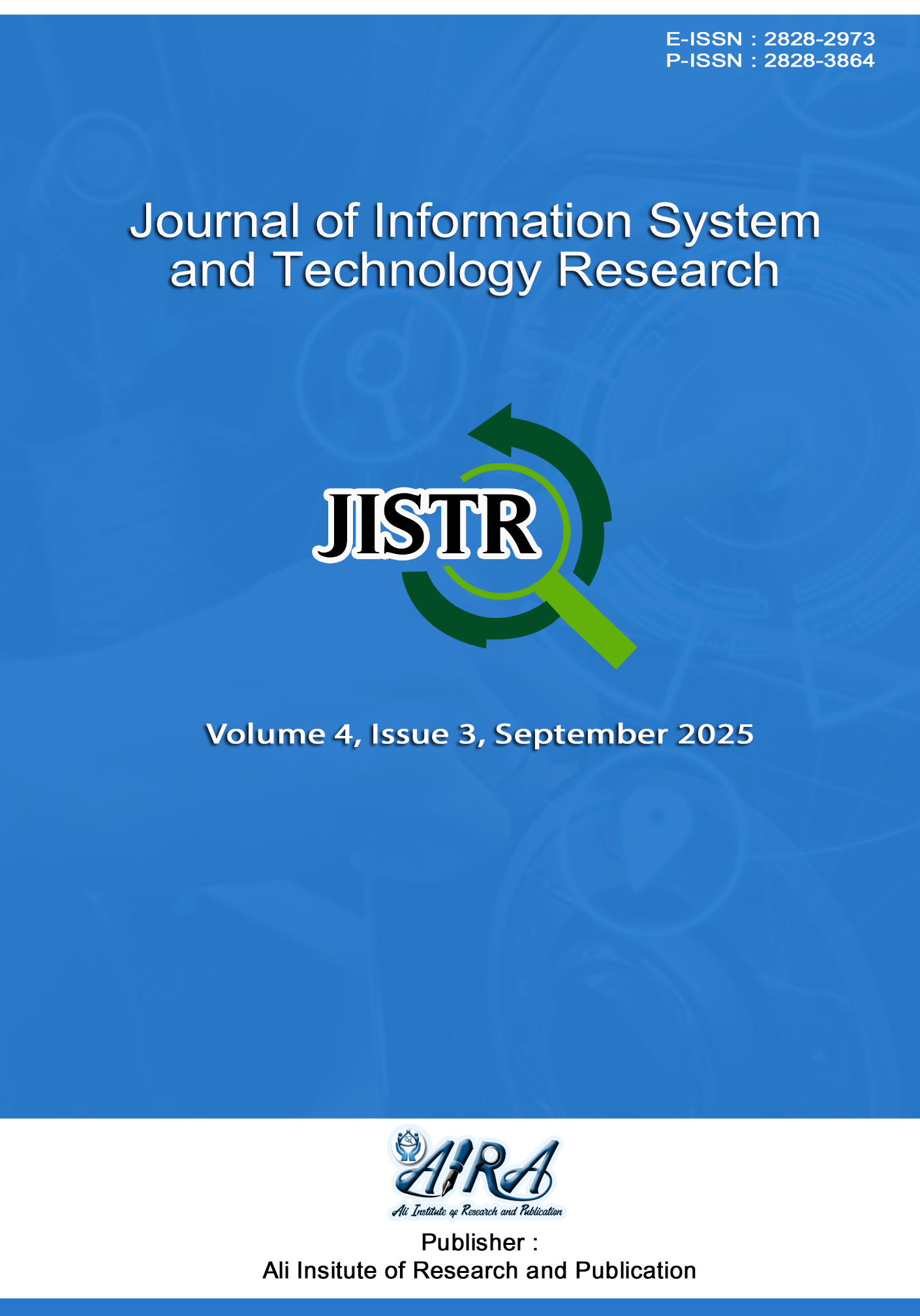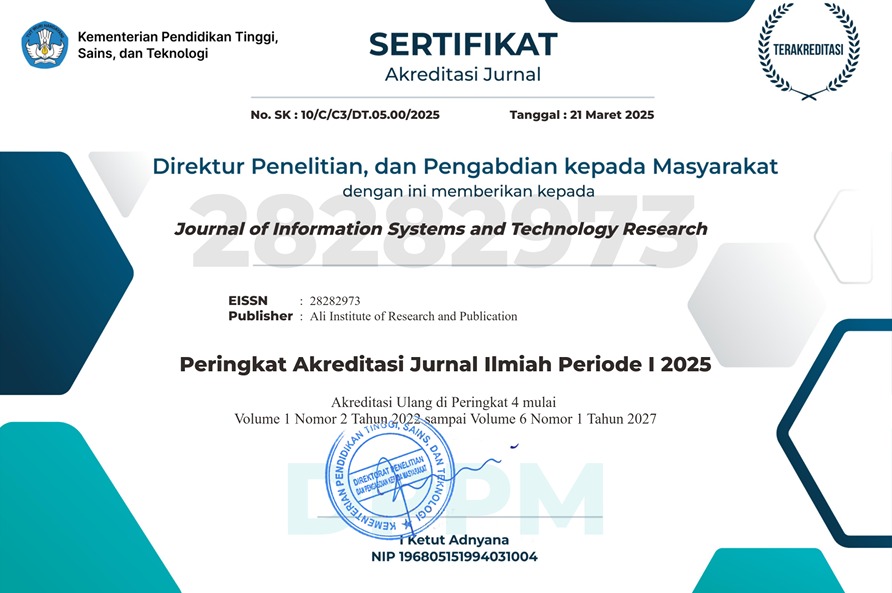Deep Learning-Based Sentiment and Emotion Analysis of Social Media Data to Identify Factors Affecting Healthy Food Choices in Urban Communities
DOI:
https://doi.org/10.55537/jistr.v4i3.1288Keywords:
Deep Learning, Sentiment Analysis, Emotion Analysis , Social Media, Healthy Food Choices, Urban Communities, Public Health, Natural Language ProcessingAbstract
The increasing influence of social media on public perception has made it a powerful driver of dietary behavior in urban communities. Nevertheless, the abundance of unverified health information often obscures individuals’ ability to make informed food choices. This study proposes a deep learning-based framework to analyze sentiment and emotion from social media discourse in order to uncover the key factors affecting healthy food decisions in urban settings. By applying Natural Language Processing (NLP) techniques and advanced deep learning models to a large corpus of user-generated content, the research identifies significant patterns linking emotional expression with food-related decision-making. The results indicate that positive emotions, such as pride and satisfaction, are strongly associated with healthy food promotion, while negative emotions, including frustration, are predominantly tied to affordability, accessibility, and convenience issues. Among these, price and food quality emerge as the most critical determinants shaping consumer preferences. These findings underscore the importance of integrating emotional and socio-economic considerations into public health strategies. Beyond offering empirical insights, this study demonstrates the scalability and effectiveness of deep learning in extracting nuanced perspectives from unstructured social media data, thereby contributing a robust methodological approach for real-time public health monitoring and intervention design.
Downloads
References
[1] M. M. Agüero-Torales, J. I. Abreu Salas, and A. G. López-Herrera, “Deep learning and multilingual sentiment analysis on social media data: An overview,” Appl. Soft Comput., vol. 107, p. 107373, 2021, doi: 10.1016/j.asoc.2021.107373.
[2] M. Anjali and K. Yadav, “Emotion Detection in Social Media Posts Using Deep Learning Techniques,” vol. 12, no. 1, pp. 3397–3398, 2025.
[3] C. A. Iglesias and A. Moreno, Sentiment analysis for social media, vol. 9, no. 23. 2019. doi: 10.3390/app9235037.
[4] M. S. Alam, M. S. H. Mrida, and M. A. Rahman, “Sentiment Analysis in Social Media: How Data Science Impacts Public Opinion Knowledge Integrates Natural Language Processing (Nlp) With Artificial Intelligence (Ai),” Am. J. Sch. Res. Innov., vol. 4, no. 1, pp. 63–100, 2025, doi: 10.63125/r3sq6p80.
[5] J. Logeesan, Y. Rishoban, and H. A. Caldera, “Automatic Summarization of Stock Market News Articles,” ACM Int. Conf. Proceeding Ser., pp. 1–5, 2020, doi: 10.1145/3443279.3443289.
[6] X. Li and Z. Ma, “Computational pragmatics: A survey in China and the world,” ACM Int. Conf. Proceeding Ser., pp. 65–69, 2018, doi: 10.1145/3278293.3278304.
[7] L. Nemes and A. Kiss, “Social media sentiment analysis based on COVID-19,” J. Inf. Telecommun., vol. 5, no. 1, pp. 1–15, 2021, doi: 10.1080/24751839.2020.1790793.
[8] I. P. Benitez, A. M. Sison, and R. P. Medina, “Implementation of GA-based feature selection in the classification and mapping of disaster-related tweets,” ACM Int. Conf. Proceeding Ser., pp. 1–6, 2018, doi: 10.1145/3278293.3278297.
[9] Z. Drus and H. Khalid, “Sentiment analysis in social media and its application: Systematic literature review,” Procedia Comput. Sci., vol. 161, pp. 707–714, 2019, doi: 10.1016/j.procs.2019.11.174.
[10] Nikhil Sanjay Suryawanshi, “Sentiment analysis with machine learning and deep learning: A survey of techniques and applications,” Int. J. Sci. Res. Arch., vol. 12, no. 2, pp. 005–015, 2024, doi: 10.30574/ijsra.2024.12.2.1205.
[11] B. Alafwan, M. Siallagan, and U. S. Putro, “Comments Analysis on Social Media: A Review,” EAI Endorsed Trans. Scalable Inf. Syst., vol. 10, no. 6, 2023, doi: 10.4108/eetsis.3843.
[12] X. L. Hou, N. Becker, T. Q. Hu, M. Koch, J. Z. Xi, and R. Mõttus, “Do Grittier People Have Greater Subjective Well-Being? A Meta-Analysis,” Personal. Soc. Psychol. Bull., vol. 48, no. 12, pp. 1701–1716, 2022, doi: 10.1177/01461672211053453.
[13] L. Daniel and M. Taj, “Dry eye disease in patients with alcohol use disorder,” TNOA J. Ophthalmic Sci. Res., vol. 60, no. 2, p. 166, 2022, doi: 10.4103/tjosr.tjosr_157_21.
[14] S. S. Almalki, “Sentiment Analysis and Emotion Detection Using Transformer Models in Multilingual Social Media Data,” Int. J. Adv. Comput. Sci. Appl., vol. 16, no. 3, pp. 324–333, 2025, doi: 10.14569/IJACSA.2025.0160332.
[15] H. H. Nguyen, “Enhancing Sentiment Analysis on Social Media Data with Advanced Deep Learning Techniques,” Int. J. Adv. Comput. Sci. Appl., vol. 15, no. 5, pp. 970–980, 2024, doi: 10.14569/IJACSA.2024.0150598.
[16] A. Chowanda, R. Sutoyo, Meiliana, and S. Tanachutiwat, “Exploring Text-based Emotions Recognition Machine Learning Techniques on Social Media Conversation,” Procedia Comput. Sci., vol. 179, no. 2019, pp. 821–828, 2021, doi: 10.1016/j.procs.2021.01.099.
[17] L. Laestadius, A. Bishop, M. Gonzalez, D. Illenčík, and C. Campos-Castillo, “Too human and not human enough: A grounded theory analysis of mental health harms from emotional dependence on the social chatbot Replika,” New Media Soc., vol. 26, no. 10, pp. 5923–5941, 2024, doi: 10.1177/14614448221142007.
[18] L. Coulbault et al., “Trimethylamine N-oxide ( TMAO ) and indoxyl sulfate concentrations in patients with Alcohol Use Disorder To cite this version : HAL Id : inserm-04145571 Trimethylamine N-oxide ( TMAO ) and indoxyl sulfate concen- trations in patients with Alcohol Use Diso,” 2023.
[19] G. Suchaneck and E. Artiukh, “Absence of Weak Localization Effects in Strontium Ferromolybdate,” Appl. Sci., vol. 13, no. 12, 2023, doi: 10.3390/app13127096.
[20] L. Zhang and L. Corporation, “RAAF Richmond,” A + U-Architecture Urban., no. 487, p. 121, 2011.
[21] D. Sumarna, D. Suh, U. Utomo, N. S. Purba, T. Romadhon, and N. Musdalifah, The Effect of Color on -Carotene Content in the Processing Stage of Red Palm Olein ( RPOn ), vol. 2024, no. Ictaff. Atlantis Press International BV, 2024. doi: 10.2991/978-94-6463-825-7.
[22] Ö. ÇELİK, U. Ö. OSMANOĞLU, and B. ÇANAKÇI, “Sentiment Analysis From Social Media Comments,” Mühendislik Bilim. ve Tasarım Derg., vol. 8, no. 2, pp. 366–374, 2020, doi: 10.21923/jesd.546224.
[23] H. Ritschel, T. Baur, and E. Andre, “Adapting a Robot’s linguistic style based on socially-Aware reinforcement learning,” RO-MAN 2017 - 26th IEEE Int. Symp. Robot Hum. Interact. Commun., vol. 2017-Janua, no. October, pp. 378–384, 2017, doi: 10.1109/ROMAN.2017.8172330.
[24] M. Buyukkececi and M. C. Okur, “A Comprehensive Review of Feature Selection and Feature Selection Stability in Machine Learning,” Gazi Univ. J. Sci., vol. 36, no. 4, pp. 1506–1520, 2023, doi: 10.35378/gujs.993763.
[25] A. R. Pathak, M. Pandey, and S. Rautaray, “Topic-level sentiment analysis of social media data using deep learning,” Appl. Soft Comput., vol. 108, no. 2021, p. 107440, 2021, doi: 10.1016/j.asoc.2021.107440.
Downloads
Published
How to Cite
Issue
Section
License
Copyright (c) 2025 Rachmat Rasyid, Muh Rafli R, Amir Karimi

This work is licensed under a Creative Commons Attribution-ShareAlike 4.0 International License.







